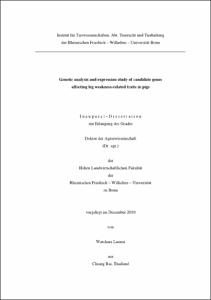Laenoi, Watchara: Genetic analysis and expression study of candidate genes affecting leg weakness-related traits in pigs. - Bonn, 2011. - Dissertation, Rheinische Friedrich-Wilhelms-Universität Bonn.
Online-Ausgabe in bonndoc: https://nbn-resolving.org/urn:nbn:de:hbz:5N-24593
Online-Ausgabe in bonndoc: https://nbn-resolving.org/urn:nbn:de:hbz:5N-24593
@phdthesis{handle:20.500.11811/4715,
urn: https://nbn-resolving.org/urn:nbn:de:hbz:5N-24593,
author = {{Watchara Laenoi}},
title = {Genetic analysis and expression study of candidate genes affecting leg weakness-related traits in pigs},
school = {Rheinische Friedrich-Wilhelms-Universität Bonn},
year = 2011,
month = mar,
volume = 151,
note = {Leg weakness (LW) problems are a great concern in the pig industry especially with regard to animal welfare. The present study was carried out to identify chromosome regions and candidate genes affecting LW-related traits in pigs. A total of 310 F2 pigs from a Duroc×Pietrain resource population were genotyped using 82 genetic markers. Front and rear legs and feet of pigs were scored according to the German standard scoring system. Osteochondrosis (OC) was histologically scored at the head and condylus medialis of the left femur and humerus. Bone mineral density (BMD) traits were measured in the whole ulna and radius bones using dual energy X-ray absorptiometry. A total of 16 QTL were identified for LW-related traits on ten porcine autosomes. All QTL reached the 5% chromosome-wide significance level. QTL on SSC2 and SSC3 for bone mineral content (BMC) and OC at head of humerus, respectively, reached the 5% genome-wide significance level which is worthwhile for further investigation. Genes known to play significant roles in endochondral ossification were selected as functional/positional candidate genes in this study. Significant association was found between SNP of MMP3 (g.158 C>T) with OC at head of femur (P<0.05) and BMD (P<0.05) in the DuPi population. Articular cartilages from 12 castrated males (6 were healthy and 6 were diseased, and each healthy and disease pairs were full-sibling used for genes expression study. TGFβ1 and RUNX2 genes were higher expressed in OC (P<0.05) compared to healthy cartilage. On the other hand, MGP was lower expressed in OC but the expression of COL2A1, MMP9 and SOX9 mRNA abundance was not different. Moreover, the expression of MGP protein was lower (P<0.05) in the OC group when quantified by Western blot. One CpG region was identified in MGP promoter and DNA methylation of three CpG sites were higher in OC compared with normal cartilage. Immunofluorescence of normal articular cartilage collected from pigs at different ages revealed that MGP signals were higher in younger pigs and decreased in the older pigs. The MGP protein was expressed more near to the cartilage canals. These results suggest that the MGP gene might be a potential candidate gene for the development of OC in pigs. In summary, the results provided information on QTL regions and candidate genes for leg weakness-related traits in pigs.},
url = {https://hdl.handle.net/20.500.11811/4715}
}
urn: https://nbn-resolving.org/urn:nbn:de:hbz:5N-24593,
author = {{Watchara Laenoi}},
title = {Genetic analysis and expression study of candidate genes affecting leg weakness-related traits in pigs},
school = {Rheinische Friedrich-Wilhelms-Universität Bonn},
year = 2011,
month = mar,
volume = 151,
note = {Leg weakness (LW) problems are a great concern in the pig industry especially with regard to animal welfare. The present study was carried out to identify chromosome regions and candidate genes affecting LW-related traits in pigs. A total of 310 F2 pigs from a Duroc×Pietrain resource population were genotyped using 82 genetic markers. Front and rear legs and feet of pigs were scored according to the German standard scoring system. Osteochondrosis (OC) was histologically scored at the head and condylus medialis of the left femur and humerus. Bone mineral density (BMD) traits were measured in the whole ulna and radius bones using dual energy X-ray absorptiometry. A total of 16 QTL were identified for LW-related traits on ten porcine autosomes. All QTL reached the 5% chromosome-wide significance level. QTL on SSC2 and SSC3 for bone mineral content (BMC) and OC at head of humerus, respectively, reached the 5% genome-wide significance level which is worthwhile for further investigation. Genes known to play significant roles in endochondral ossification were selected as functional/positional candidate genes in this study. Significant association was found between SNP of MMP3 (g.158 C>T) with OC at head of femur (P<0.05) and BMD (P<0.05) in the DuPi population. Articular cartilages from 12 castrated males (6 were healthy and 6 were diseased, and each healthy and disease pairs were full-sibling used for genes expression study. TGFβ1 and RUNX2 genes were higher expressed in OC (P<0.05) compared to healthy cartilage. On the other hand, MGP was lower expressed in OC but the expression of COL2A1, MMP9 and SOX9 mRNA abundance was not different. Moreover, the expression of MGP protein was lower (P<0.05) in the OC group when quantified by Western blot. One CpG region was identified in MGP promoter and DNA methylation of three CpG sites were higher in OC compared with normal cartilage. Immunofluorescence of normal articular cartilage collected from pigs at different ages revealed that MGP signals were higher in younger pigs and decreased in the older pigs. The MGP protein was expressed more near to the cartilage canals. These results suggest that the MGP gene might be a potential candidate gene for the development of OC in pigs. In summary, the results provided information on QTL regions and candidate genes for leg weakness-related traits in pigs.},
url = {https://hdl.handle.net/20.500.11811/4715}
}






